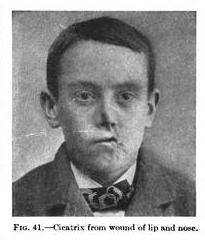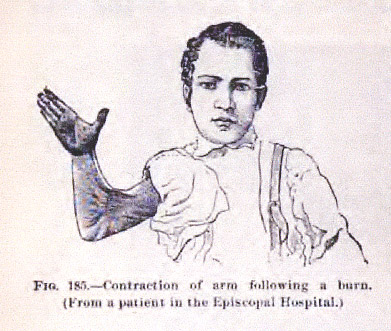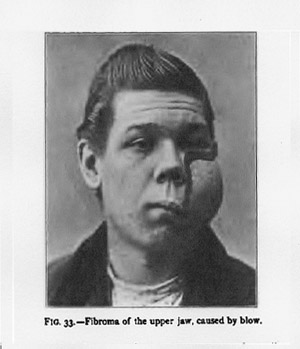
The College of Physicians of Philadelphia.
There are a trove of DeForest Willard related images – sixteen by my count. Several of them were used to illustrate his monumental orthopedic work titled, The surgery of childhood, 24 in which he thanks Dr. [Joseph M.] Spellissy, and Miss Anna S. Kite for their photographs. Spellissy directed the department of photography and anthropometry of the Pennsylvania University Hospital at the time and Willard gives a nod to his scoliosis photography on page 263. I was able to identify eight of the Mütters in the Willard work as follows: a version of the Mütter page 6 photograph appears in Willard on page 222, Fig. 146;

a version of Mütter page 25 is in Willard on page 49, Fig. 41;


Mütter page 18, center photo of rickets, appears in Willard on page 302; Mütter page 49, top and bottom images, are in Willard on pages 462-463; Mütter page 94, top image, is in Willard on page 751 with another image of the boy squatting; Mütter page 97 bottom image is cropped in Willard on page 575; Mütter page 109 photo is cropped in Willard on page 625 — the image was also used by James Kelly Young to illustrate his orthopedic monograph published in 1894. 25 Young's book also reproduces the two amelia images appearing on page 141 of the first Mütter volume. Finally, Mütter page 115 is in Willard on page 223, Fig. 147, as a close-up.

The photograph on page 41 is incorrectly captioned. The subject is not trauma from shark bite, but rather trauma from burns, and the patient is not that of Dr. Harte, but of John Ashhurst, Jr., the author of an encyclopedic volume on surgery titled, The principles and practice of surgery, 26 which went through numerous editions. Ashhurst discusses his case on page 334 and includes woodcut reproductions of both photographs seen in the Mütter atlas. Dr. Harte's case of shark bite is also discussed in the Ashhurst on page 167.
Five other photographs from the Mütter Historic Photographs collection can also be found in the Ashhurst work, either as woodcut reproductions or as details of the photographs. They are as follows: the triple amputee portrayed on page 65 is a woodcut on page 117 of the Ashhurst — the 9 year-old boy was saved by Dr. W. B. Lowman of Johnstown, Pa. and the case was first reported by Dr. James McCann in 1884. 27 A woodcut of the photo also appears in Mears, Practical Surgery 28 on page 606. Crater tumor shown on page 146 of the Mütter (case of De Schweinitz) is a photo detail on page 566 of the Ashhurst; Muybridge's photos in Mütter, page 128, are woodcuts in Ashhurst, page 632, and on page 319 of the Young monograph ; the nephrotomy in Mütter, page 120, a case of Dr. L. McLane Tiffany is a photo detail in Ashhurst, page 965; the photograph on page 127 of the Mütter is a woodcut on page 669 of the Ashhurst:

— in the Mütter book, it is captioned,
"Osteitis deformans (Paget's disease of bone)." In fact, it is a case of anchylosis from hip disease — most
likely tubercular in origin — which Ashhurst treated successfully with osteotomy of both femurs. The woodcut
reproduction which appears in Ashhurst with the imaginary figure of the mother holding her daughter,
is alongside another woodcut showing the patient after full recovery from the surgery.

I counted seven photographs attributed to William H. Rhoads falling on pages 33, two on 40, 62, 177, 181, and 207. Besides the pair on page 40 discussed above, I found only one other reference in the literature — for the image falling on page 177 of the Mütter. This photograph was used by J. Ewing Mears for his paper titled "Diseases of the jaws and gums, pharynx, and tonsils," published in J. C. Warren's, International text-book of surgery. 29 There the photograph is captioned, "Fig. 33. — Fibroma of the upper jaw, caused by blow." On page 57 of the first Mütter volume (2002) thare are two William H. Rhoads photographs of a subject that can be identified on page 58 of the Warren:

The photograph of Fo Lim on page 152 is a very important artifact of American history. Sometime during the 1870's he became one of the first leper patients treated by Dr. John W. Foye who was resident physician at San Francisco City and County Small-pox Hospital. Fo Lim was moved out of the hospital to another facility, from what can be surmised by the caption of the photograph and from information in Foye's report which he delivered to the American Dermatological Association in December of 1881. Foye reported that the hospital only accepted the leprosic under duress and only when no accommodations were available in other institutions. His first patient was admitted in 1871, but there followed an increase of the disease in the immigrant Chinese community which so alarmed the citizens of San Francisco that they began deporting groups of the infected, including Fo Lim, back to their homeland China. Foyes report was titled, Special report on leprosy, 30 and an excerpt follows:
Per contra Fo Lim and To Gan were both inmates of the
hospital two years or more ; were both the subjects of the
disease several years prior to admission, and were in better
physical condition when discharged than when admitted. The
former had been eight years in the country and four or five
years the subject of the disease. Ulceration had commenced in
the fossa between the lower lip and prominence of the chin,
but under a more generous diet than he had been accustomed
to, it soon healed, and his general health continued good during
the period of his stay in the hospital.
For the past two years alimentation has been our only treatment.
The leper requires good nutrition and wants it often.
The ration of the American army is insufficient for his support
until the last stage of the disease has been reached.
General Prevalence.—Any opinion as to the number of these
unfortunates now in the city would be mere conjecture. I
have seen none out of the Chinese quarter, and without police
aid it would be useless to look for it there. It is less general
than is commonly believed, yet the fact is a significant one,
that, on the 2d of June, every known leper in the city was
shipped for China, and before the end of the year fourteen new
cases have accumulated upon our hands. The Chinese Consul
claims hospital rights for these people; the authorities resist the
claim, and the courts are now adjudicating upon the question. — page 624.
Accompanying these notes you will find a photographic group of lepers, fourteen in number. They comprise the second shipment made to China, June the 2d, 1880. You will also find two cabinet scenes from the same group—fine specimens of the tubercular type of the disease just prior to the commencement of the ulcerative process. — page 623.
Dr. Duhring was in attendance at this meeting and it is quite possible that he returned to Philadelphia with this photograph.
Falling on page 153 is an image of neurofibromatosis which was reproduced as a woodcut on page 616 of A System of Surgery: Pathological, Diagnostic, Therapeutic, and Operative 31 written by Samuel David Gross with credit to Dr. Kerr in the text.
24.) Willard, DeForest, (1910), The surgery of childhood, including orthopædic surgery. Philadelphia: J. B.
Lippincott Company.
25.) Young, James Kelly, (1894), A Practical Treatise on Orthopedic Surgery. Philadelphia: Leas Brothers & Co.;
page 227.
26.) Ashhurst, John, (1893), The Principles and practice of surgery. Philadelphia: Leas Brothers & Co.; sixth edition.
27.) McCann, James, (1884), Clinical observations on the treatment of severe railroad injuries of the extremities.
Philadelphia: "Transactions of the American Surgical Association"; vol. ii, pages ii, 197-235.
28.) Mears, James Ewing, (1984), Practical surgery: including surgical dressings, bandaging, fractures, dislocations,
ligature of arteries, amputations, and excisions of bones and joints. Philadelphia: P. Blakiston, son & co.; page 606.
29.) Warren, John Collins, (1900), International text-book of surgery. Philadelphia: W. B. Saunders; vol. 2.
30.) Foye, John W., (1882), Special report on leprosy. Chicago: Chicago Medical Press Association; "Transactions
of the American Dermatological Association"; pages 40-44.
31.) Gross, Samuel David, (1872), A System of Surgery: Pathological, Diagnostic, Therapeutic, and Operative.
Philadelphia: Henry C. Lea; page 616.
